Chemical Oxygen Demand (COD) Analysis: Water Quality Assessment Report
VerifiedAdded on 2023/04/22
|7
|1652
|378
Report
AI Summary
This report provides a comprehensive analysis of Chemical Oxygen Demand (COD), a crucial parameter for assessing water quality. It explores the COD test's methodology, which involves oxidizing organic and inorganic substances in water samples using potassium dichromate. The report details the process, including the use of silver sulphate and mercuric sulphate, and discusses the role of UV-VIS spectroscopy as a monitoring technique. It highlights the differences between COD and Biochemical Oxygen Demand (BOD), emphasizing COD's advantages in certain scenarios. Furthermore, the report addresses the limitations of traditional COD methods and proposes a spectrometer-based approach to overcome these challenges, promoting efficiency and reducing chemical waste. The study concludes with a discussion on the accuracy of the COD test and its validation, referencing various sources to support the findings. The report underscores the importance of COD in environmental monitoring and its application in industrial and domestic wastewater analysis.
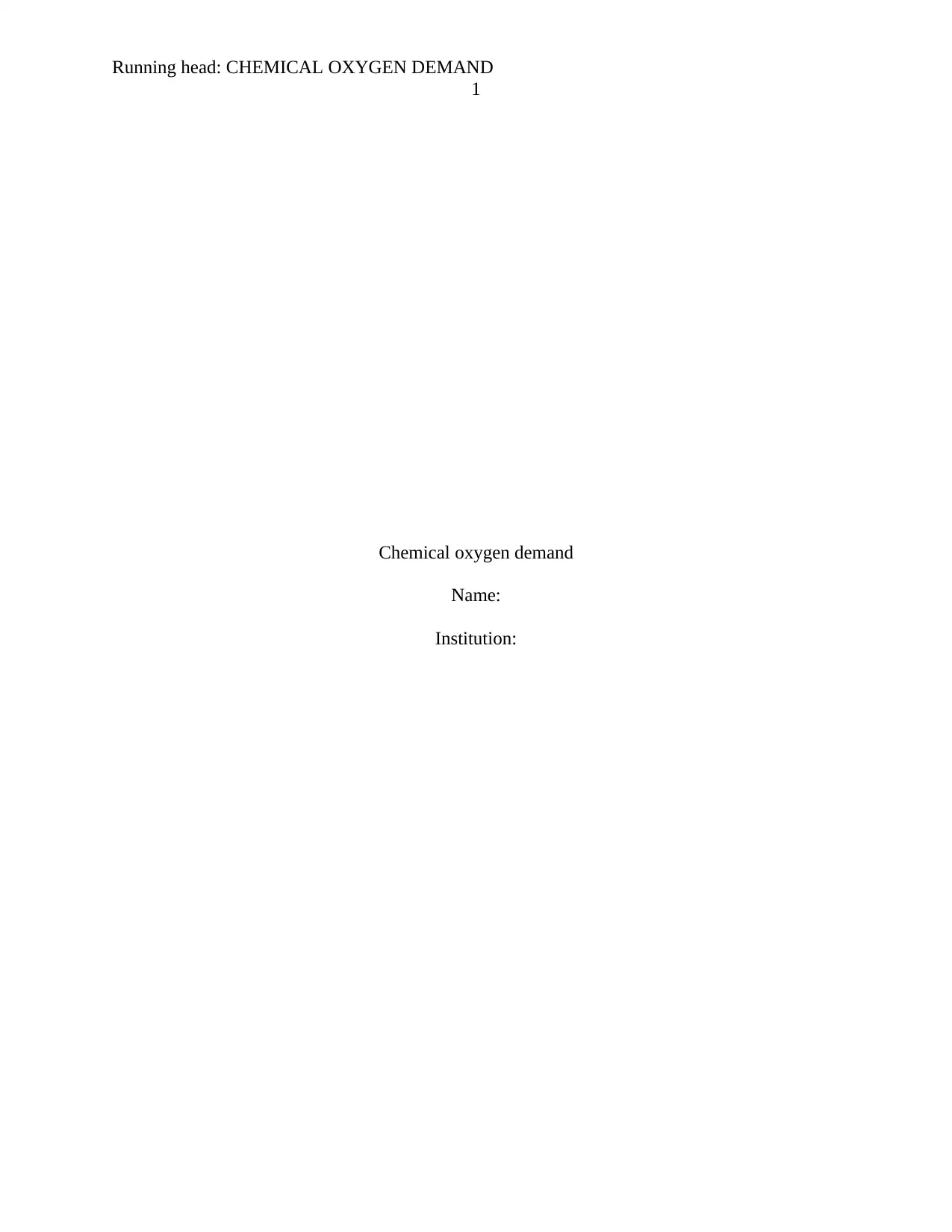
Running head: CHEMICAL OXYGEN DEMAND
1
Chemical oxygen demand
Name:
Institution:
1
Chemical oxygen demand
Name:
Institution:
Paraphrase This Document
Need a fresh take? Get an instant paraphrase of this document with our AI Paraphraser
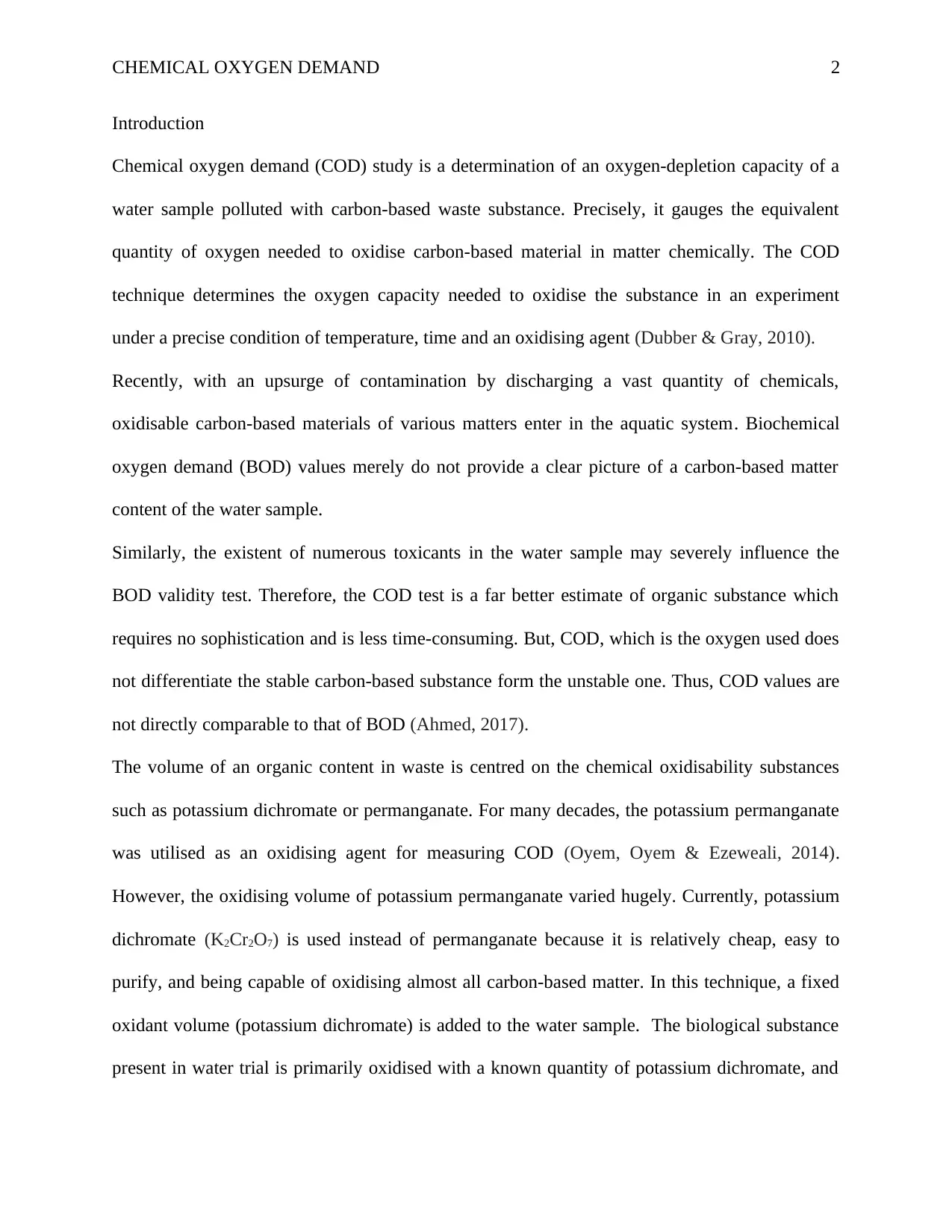
CHEMICAL OXYGEN DEMAND 2
Introduction
Chemical oxygen demand (COD) study is a determination of an oxygen-depletion capacity of a
water sample polluted with carbon-based waste substance. Precisely, it gauges the equivalent
quantity of oxygen needed to oxidise carbon-based material in matter chemically. The COD
technique determines the oxygen capacity needed to oxidise the substance in an experiment
under a precise condition of temperature, time and an oxidising agent (Dubber & Gray, 2010).
Recently, with an upsurge of contamination by discharging a vast quantity of chemicals,
oxidisable carbon-based materials of various matters enter in the aquatic system. Biochemical
oxygen demand (BOD) values merely do not provide a clear picture of a carbon-based matter
content of the water sample.
Similarly, the existent of numerous toxicants in the water sample may severely influence the
BOD validity test. Therefore, the COD test is a far better estimate of organic substance which
requires no sophistication and is less time-consuming. But, COD, which is the oxygen used does
not differentiate the stable carbon-based substance form the unstable one. Thus, COD values are
not directly comparable to that of BOD (Ahmed, 2017).
The volume of an organic content in waste is centred on the chemical oxidisability substances
such as potassium dichromate or permanganate. For many decades, the potassium permanganate
was utilised as an oxidising agent for measuring COD (Oyem, Oyem & Ezeweali, 2014).
However, the oxidising volume of potassium permanganate varied hugely. Currently, potassium
dichromate (K2Cr2O7) is used instead of permanganate because it is relatively cheap, easy to
purify, and being capable of oxidising almost all carbon-based matter. In this technique, a fixed
oxidant volume (potassium dichromate) is added to the water sample. The biological substance
present in water trial is primarily oxidised with a known quantity of potassium dichromate, and
Introduction
Chemical oxygen demand (COD) study is a determination of an oxygen-depletion capacity of a
water sample polluted with carbon-based waste substance. Precisely, it gauges the equivalent
quantity of oxygen needed to oxidise carbon-based material in matter chemically. The COD
technique determines the oxygen capacity needed to oxidise the substance in an experiment
under a precise condition of temperature, time and an oxidising agent (Dubber & Gray, 2010).
Recently, with an upsurge of contamination by discharging a vast quantity of chemicals,
oxidisable carbon-based materials of various matters enter in the aquatic system. Biochemical
oxygen demand (BOD) values merely do not provide a clear picture of a carbon-based matter
content of the water sample.
Similarly, the existent of numerous toxicants in the water sample may severely influence the
BOD validity test. Therefore, the COD test is a far better estimate of organic substance which
requires no sophistication and is less time-consuming. But, COD, which is the oxygen used does
not differentiate the stable carbon-based substance form the unstable one. Thus, COD values are
not directly comparable to that of BOD (Ahmed, 2017).
The volume of an organic content in waste is centred on the chemical oxidisability substances
such as potassium dichromate or permanganate. For many decades, the potassium permanganate
was utilised as an oxidising agent for measuring COD (Oyem, Oyem & Ezeweali, 2014).
However, the oxidising volume of potassium permanganate varied hugely. Currently, potassium
dichromate (K2Cr2O7) is used instead of permanganate because it is relatively cheap, easy to
purify, and being capable of oxidising almost all carbon-based matter. In this technique, a fixed
oxidant volume (potassium dichromate) is added to the water sample. The biological substance
present in water trial is primarily oxidised with a known quantity of potassium dichromate, and
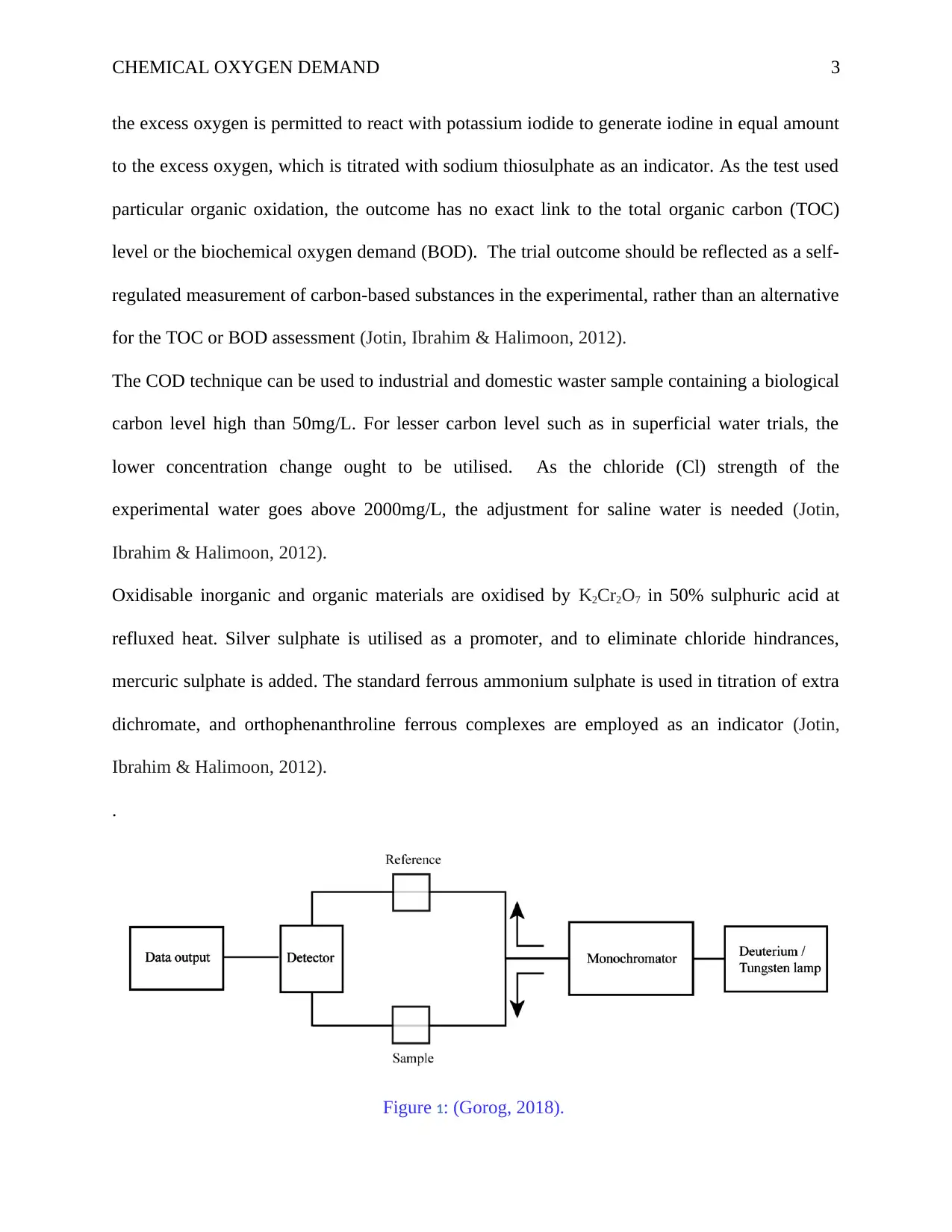
CHEMICAL OXYGEN DEMAND 3
the excess oxygen is permitted to react with potassium iodide to generate iodine in equal amount
to the excess oxygen, which is titrated with sodium thiosulphate as an indicator. As the test used
particular organic oxidation, the outcome has no exact link to the total organic carbon (TOC)
level or the biochemical oxygen demand (BOD). The trial outcome should be reflected as a self-
regulated measurement of carbon-based substances in the experimental, rather than an alternative
for the TOC or BOD assessment (Jotin, Ibrahim & Halimoon, 2012).
The COD technique can be used to industrial and domestic waster sample containing a biological
carbon level high than 50mg/L. For lesser carbon level such as in superficial water trials, the
lower concentration change ought to be utilised. As the chloride (Cl) strength of the
experimental water goes above 2000mg/L, the adjustment for saline water is needed (Jotin,
Ibrahim & Halimoon, 2012).
Oxidisable inorganic and organic materials are oxidised by K2Cr2O7 in 50% sulphuric acid at
refluxed heat. Silver sulphate is utilised as a promoter, and to eliminate chloride hindrances,
mercuric sulphate is added. The standard ferrous ammonium sulphate is used in titration of extra
dichromate, and orthophenanthroline ferrous complexes are employed as an indicator (Jotin,
Ibrahim & Halimoon, 2012).
.
Figure 1: (Gorog, 2018).
the excess oxygen is permitted to react with potassium iodide to generate iodine in equal amount
to the excess oxygen, which is titrated with sodium thiosulphate as an indicator. As the test used
particular organic oxidation, the outcome has no exact link to the total organic carbon (TOC)
level or the biochemical oxygen demand (BOD). The trial outcome should be reflected as a self-
regulated measurement of carbon-based substances in the experimental, rather than an alternative
for the TOC or BOD assessment (Jotin, Ibrahim & Halimoon, 2012).
The COD technique can be used to industrial and domestic waster sample containing a biological
carbon level high than 50mg/L. For lesser carbon level such as in superficial water trials, the
lower concentration change ought to be utilised. As the chloride (Cl) strength of the
experimental water goes above 2000mg/L, the adjustment for saline water is needed (Jotin,
Ibrahim & Halimoon, 2012).
Oxidisable inorganic and organic materials are oxidised by K2Cr2O7 in 50% sulphuric acid at
refluxed heat. Silver sulphate is utilised as a promoter, and to eliminate chloride hindrances,
mercuric sulphate is added. The standard ferrous ammonium sulphate is used in titration of extra
dichromate, and orthophenanthroline ferrous complexes are employed as an indicator (Jotin,
Ibrahim & Halimoon, 2012).
.
Figure 1: (Gorog, 2018).
⊘ This is a preview!⊘
Do you want full access?
Subscribe today to unlock all pages.

Trusted by 1+ million students worldwide
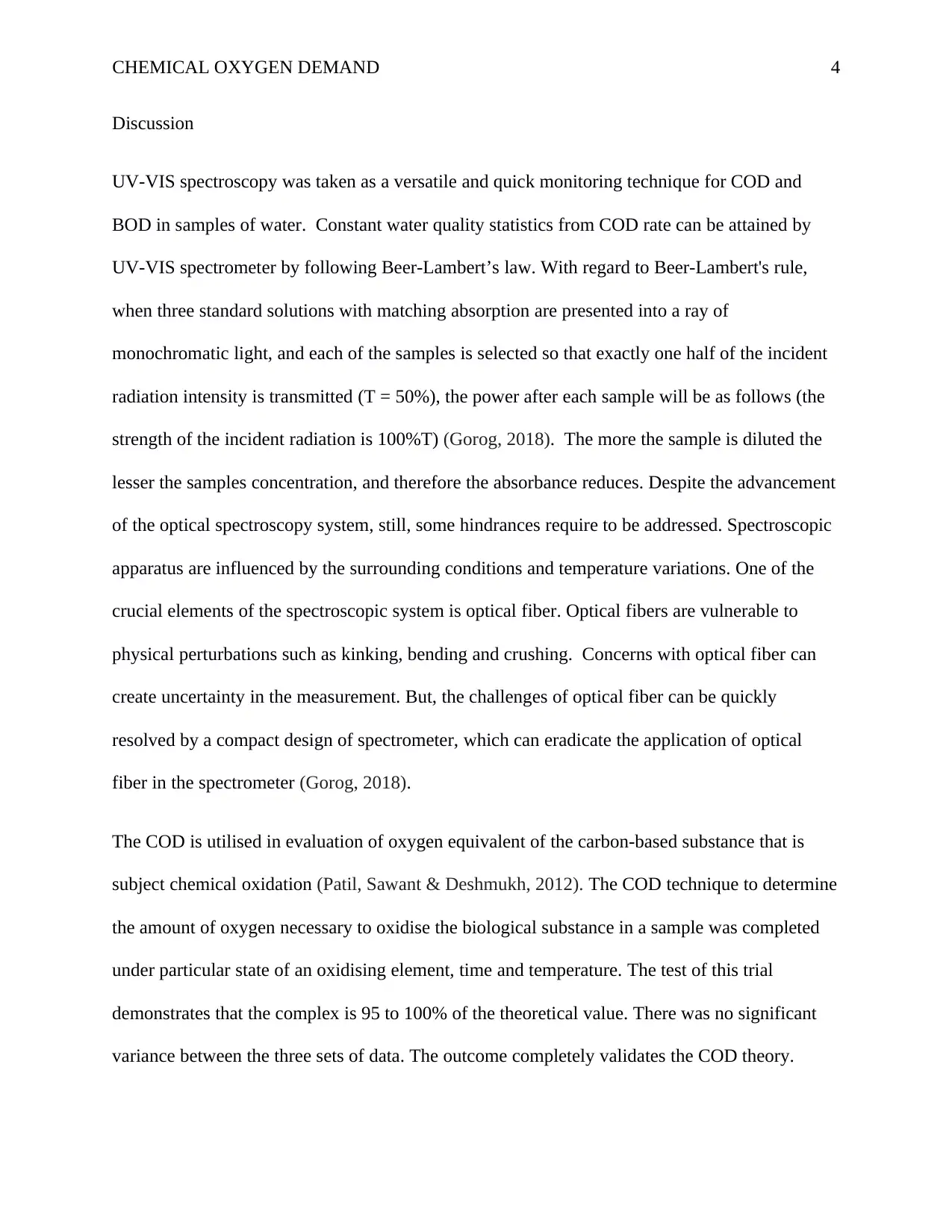
CHEMICAL OXYGEN DEMAND 4
Discussion
UV-VIS spectroscopy was taken as a versatile and quick monitoring technique for COD and
BOD in samples of water. Constant water quality statistics from COD rate can be attained by
UV-VIS spectrometer by following Beer-Lambert’s law. With regard to Beer-Lambert's rule,
when three standard solutions with matching absorption are presented into a ray of
monochromatic light, and each of the samples is selected so that exactly one half of the incident
radiation intensity is transmitted (T = 50%), the power after each sample will be as follows (the
strength of the incident radiation is 100%T) (Gorog, 2018). The more the sample is diluted the
lesser the samples concentration, and therefore the absorbance reduces. Despite the advancement
of the optical spectroscopy system, still, some hindrances require to be addressed. Spectroscopic
apparatus are influenced by the surrounding conditions and temperature variations. One of the
crucial elements of the spectroscopic system is optical fiber. Optical fibers are vulnerable to
physical perturbations such as kinking, bending and crushing. Concerns with optical fiber can
create uncertainty in the measurement. But, the challenges of optical fiber can be quickly
resolved by a compact design of spectrometer, which can eradicate the application of optical
fiber in the spectrometer (Gorog, 2018).
The COD is utilised in evaluation of oxygen equivalent of the carbon-based substance that is
subject chemical oxidation (Patil, Sawant & Deshmukh, 2012). The COD technique to determine
the amount of oxygen necessary to oxidise the biological substance in a sample was completed
under particular state of an oxidising element, time and temperature. The test of this trial
demonstrates that the complex is 95 to 100% of the theoretical value. There was no significant
variance between the three sets of data. The outcome completely validates the COD theory.
Discussion
UV-VIS spectroscopy was taken as a versatile and quick monitoring technique for COD and
BOD in samples of water. Constant water quality statistics from COD rate can be attained by
UV-VIS spectrometer by following Beer-Lambert’s law. With regard to Beer-Lambert's rule,
when three standard solutions with matching absorption are presented into a ray of
monochromatic light, and each of the samples is selected so that exactly one half of the incident
radiation intensity is transmitted (T = 50%), the power after each sample will be as follows (the
strength of the incident radiation is 100%T) (Gorog, 2018). The more the sample is diluted the
lesser the samples concentration, and therefore the absorbance reduces. Despite the advancement
of the optical spectroscopy system, still, some hindrances require to be addressed. Spectroscopic
apparatus are influenced by the surrounding conditions and temperature variations. One of the
crucial elements of the spectroscopic system is optical fiber. Optical fibers are vulnerable to
physical perturbations such as kinking, bending and crushing. Concerns with optical fiber can
create uncertainty in the measurement. But, the challenges of optical fiber can be quickly
resolved by a compact design of spectrometer, which can eradicate the application of optical
fiber in the spectrometer (Gorog, 2018).
The COD is utilised in evaluation of oxygen equivalent of the carbon-based substance that is
subject chemical oxidation (Patil, Sawant & Deshmukh, 2012). The COD technique to determine
the amount of oxygen necessary to oxidise the biological substance in a sample was completed
under particular state of an oxidising element, time and temperature. The test of this trial
demonstrates that the complex is 95 to 100% of the theoretical value. There was no significant
variance between the three sets of data. The outcome completely validates the COD theory.
Paraphrase This Document
Need a fresh take? Get an instant paraphrase of this document with our AI Paraphraser
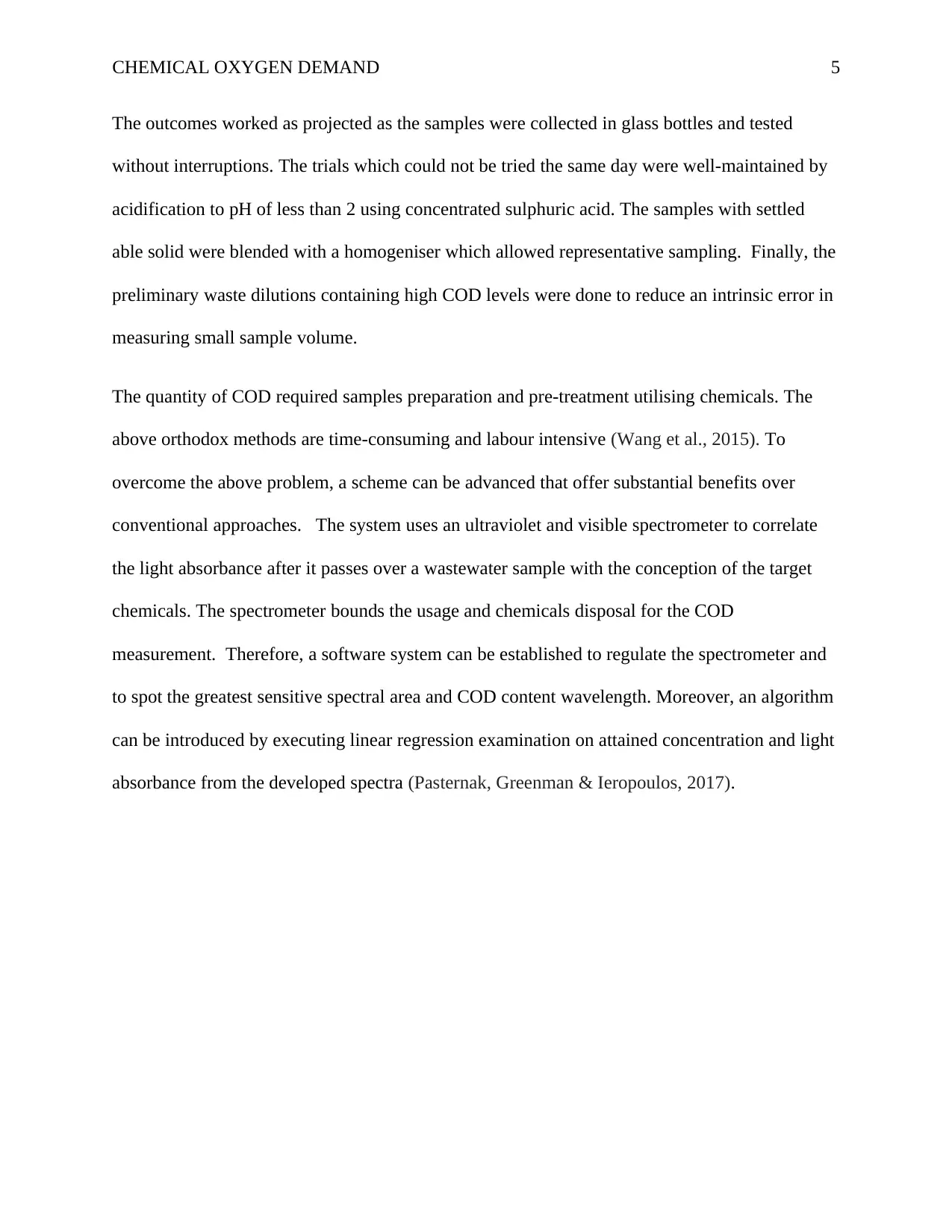
CHEMICAL OXYGEN DEMAND 5
The outcomes worked as projected as the samples were collected in glass bottles and tested
without interruptions. The trials which could not be tried the same day were well-maintained by
acidification to pH of less than 2 using concentrated sulphuric acid. The samples with settled
able solid were blended with a homogeniser which allowed representative sampling. Finally, the
preliminary waste dilutions containing high COD levels were done to reduce an intrinsic error in
measuring small sample volume.
The quantity of COD required samples preparation and pre-treatment utilising chemicals. The
above orthodox methods are time-consuming and labour intensive (Wang et al., 2015). To
overcome the above problem, a scheme can be advanced that offer substantial benefits over
conventional approaches. The system uses an ultraviolet and visible spectrometer to correlate
the light absorbance after it passes over a wastewater sample with the conception of the target
chemicals. The spectrometer bounds the usage and chemicals disposal for the COD
measurement. Therefore, a software system can be established to regulate the spectrometer and
to spot the greatest sensitive spectral area and COD content wavelength. Moreover, an algorithm
can be introduced by executing linear regression examination on attained concentration and light
absorbance from the developed spectra (Pasternak, Greenman & Ieropoulos, 2017).
The outcomes worked as projected as the samples were collected in glass bottles and tested
without interruptions. The trials which could not be tried the same day were well-maintained by
acidification to pH of less than 2 using concentrated sulphuric acid. The samples with settled
able solid were blended with a homogeniser which allowed representative sampling. Finally, the
preliminary waste dilutions containing high COD levels were done to reduce an intrinsic error in
measuring small sample volume.
The quantity of COD required samples preparation and pre-treatment utilising chemicals. The
above orthodox methods are time-consuming and labour intensive (Wang et al., 2015). To
overcome the above problem, a scheme can be advanced that offer substantial benefits over
conventional approaches. The system uses an ultraviolet and visible spectrometer to correlate
the light absorbance after it passes over a wastewater sample with the conception of the target
chemicals. The spectrometer bounds the usage and chemicals disposal for the COD
measurement. Therefore, a software system can be established to regulate the spectrometer and
to spot the greatest sensitive spectral area and COD content wavelength. Moreover, an algorithm
can be introduced by executing linear regression examination on attained concentration and light
absorbance from the developed spectra (Pasternak, Greenman & Ieropoulos, 2017).
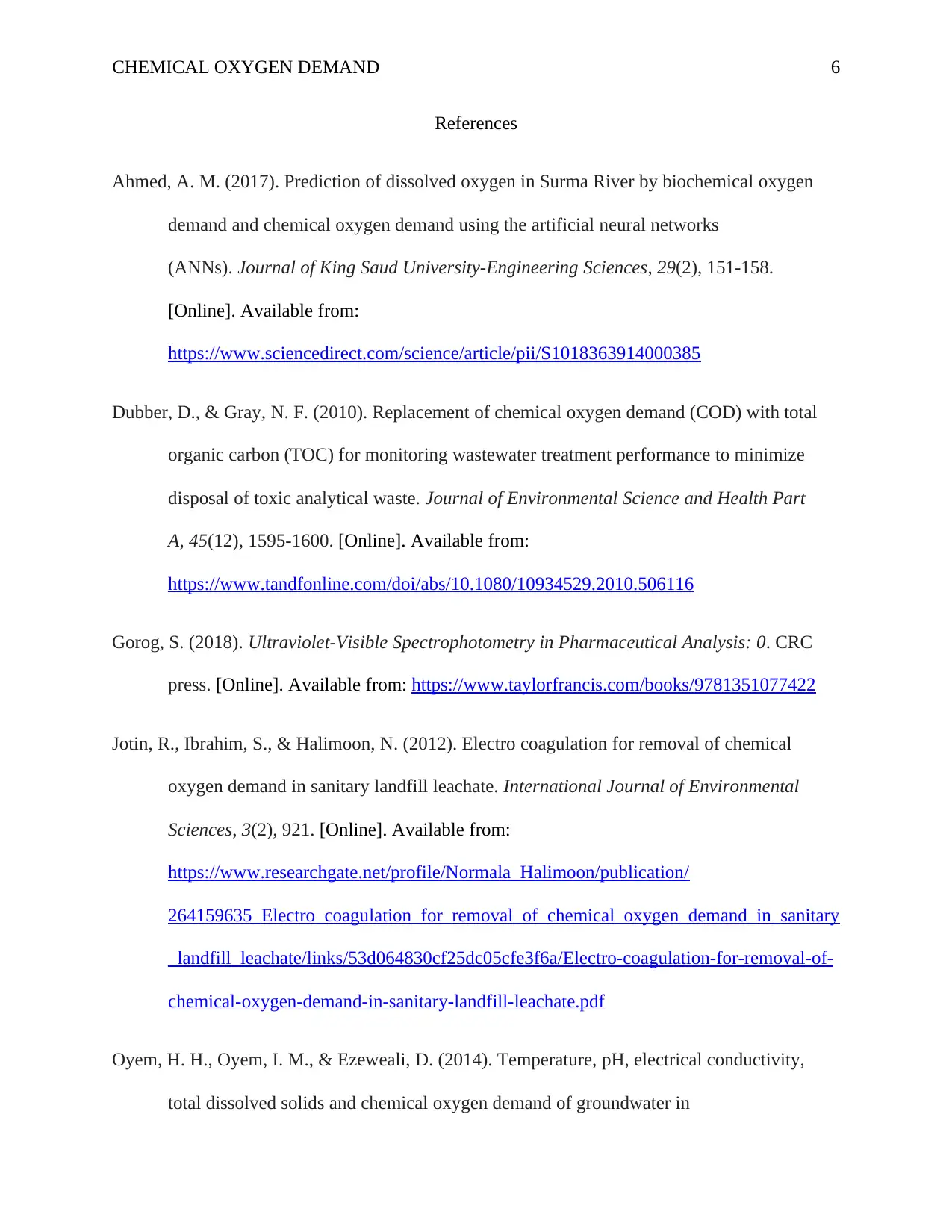
CHEMICAL OXYGEN DEMAND 6
References
Ahmed, A. M. (2017). Prediction of dissolved oxygen in Surma River by biochemical oxygen
demand and chemical oxygen demand using the artificial neural networks
(ANNs). Journal of King Saud University-Engineering Sciences, 29(2), 151-158.
[Online]. Available from:
https://www.sciencedirect.com/science/article/pii/S1018363914000385
Dubber, D., & Gray, N. F. (2010). Replacement of chemical oxygen demand (COD) with total
organic carbon (TOC) for monitoring wastewater treatment performance to minimize
disposal of toxic analytical waste. Journal of Environmental Science and Health Part
A, 45(12), 1595-1600. [Online]. Available from:
https://www.tandfonline.com/doi/abs/10.1080/10934529.2010.506116
Gorog, S. (2018). Ultraviolet-Visible Spectrophotometry in Pharmaceutical Analysis: 0. CRC
press. [Online]. Available from: https://www.taylorfrancis.com/books/9781351077422
Jotin, R., Ibrahim, S., & Halimoon, N. (2012). Electro coagulation for removal of chemical
oxygen demand in sanitary landfill leachate. International Journal of Environmental
Sciences, 3(2), 921. [Online]. Available from:
https://www.researchgate.net/profile/Normala_Halimoon/publication/
264159635_Electro_coagulation_for_removal_of_chemical_oxygen_demand_in_sanitary
_landfill_leachate/links/53d064830cf25dc05cfe3f6a/Electro-coagulation-for-removal-of-
chemical-oxygen-demand-in-sanitary-landfill-leachate.pdf
Oyem, H. H., Oyem, I. M., & Ezeweali, D. (2014). Temperature, pH, electrical conductivity,
total dissolved solids and chemical oxygen demand of groundwater in
References
Ahmed, A. M. (2017). Prediction of dissolved oxygen in Surma River by biochemical oxygen
demand and chemical oxygen demand using the artificial neural networks
(ANNs). Journal of King Saud University-Engineering Sciences, 29(2), 151-158.
[Online]. Available from:
https://www.sciencedirect.com/science/article/pii/S1018363914000385
Dubber, D., & Gray, N. F. (2010). Replacement of chemical oxygen demand (COD) with total
organic carbon (TOC) for monitoring wastewater treatment performance to minimize
disposal of toxic analytical waste. Journal of Environmental Science and Health Part
A, 45(12), 1595-1600. [Online]. Available from:
https://www.tandfonline.com/doi/abs/10.1080/10934529.2010.506116
Gorog, S. (2018). Ultraviolet-Visible Spectrophotometry in Pharmaceutical Analysis: 0. CRC
press. [Online]. Available from: https://www.taylorfrancis.com/books/9781351077422
Jotin, R., Ibrahim, S., & Halimoon, N. (2012). Electro coagulation for removal of chemical
oxygen demand in sanitary landfill leachate. International Journal of Environmental
Sciences, 3(2), 921. [Online]. Available from:
https://www.researchgate.net/profile/Normala_Halimoon/publication/
264159635_Electro_coagulation_for_removal_of_chemical_oxygen_demand_in_sanitary
_landfill_leachate/links/53d064830cf25dc05cfe3f6a/Electro-coagulation-for-removal-of-
chemical-oxygen-demand-in-sanitary-landfill-leachate.pdf
Oyem, H. H., Oyem, I. M., & Ezeweali, D. (2014). Temperature, pH, electrical conductivity,
total dissolved solids and chemical oxygen demand of groundwater in
⊘ This is a preview!⊘
Do you want full access?
Subscribe today to unlock all pages.

Trusted by 1+ million students worldwide
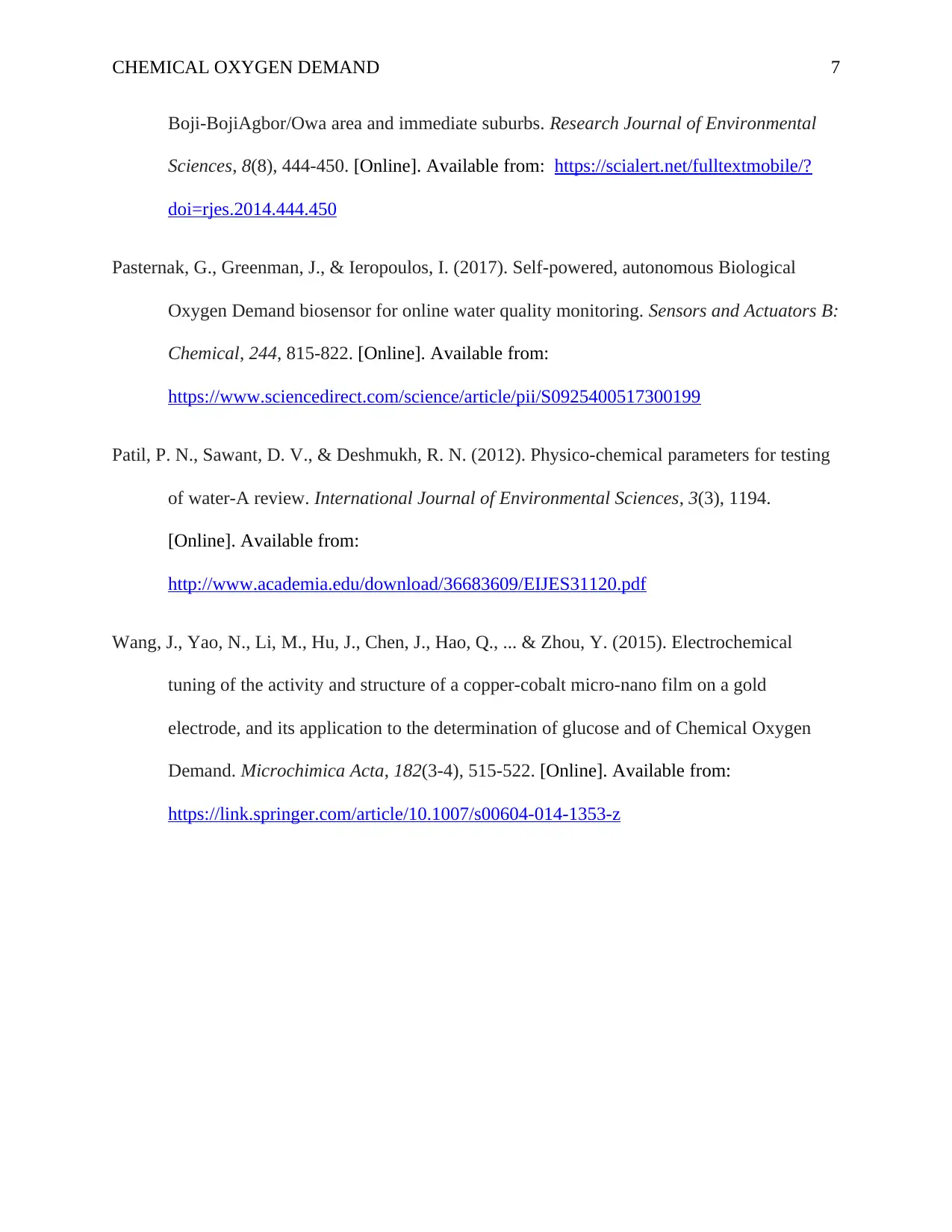
CHEMICAL OXYGEN DEMAND 7
Boji-BojiAgbor/Owa area and immediate suburbs. Research Journal of Environmental
Sciences, 8(8), 444-450. [Online]. Available from: https://scialert.net/fulltextmobile/?
doi=rjes.2014.444.450
Pasternak, G., Greenman, J., & Ieropoulos, I. (2017). Self-powered, autonomous Biological
Oxygen Demand biosensor for online water quality monitoring. Sensors and Actuators B:
Chemical, 244, 815-822. [Online]. Available from:
https://www.sciencedirect.com/science/article/pii/S0925400517300199
Patil, P. N., Sawant, D. V., & Deshmukh, R. N. (2012). Physico-chemical parameters for testing
of water-A review. International Journal of Environmental Sciences, 3(3), 1194.
[Online]. Available from:
http://www.academia.edu/download/36683609/EIJES31120.pdf
Wang, J., Yao, N., Li, M., Hu, J., Chen, J., Hao, Q., ... & Zhou, Y. (2015). Electrochemical
tuning of the activity and structure of a copper-cobalt micro-nano film on a gold
electrode, and its application to the determination of glucose and of Chemical Oxygen
Demand. Microchimica Acta, 182(3-4), 515-522. [Online]. Available from:
https://link.springer.com/article/10.1007/s00604-014-1353-z
Boji-BojiAgbor/Owa area and immediate suburbs. Research Journal of Environmental
Sciences, 8(8), 444-450. [Online]. Available from: https://scialert.net/fulltextmobile/?
doi=rjes.2014.444.450
Pasternak, G., Greenman, J., & Ieropoulos, I. (2017). Self-powered, autonomous Biological
Oxygen Demand biosensor for online water quality monitoring. Sensors and Actuators B:
Chemical, 244, 815-822. [Online]. Available from:
https://www.sciencedirect.com/science/article/pii/S0925400517300199
Patil, P. N., Sawant, D. V., & Deshmukh, R. N. (2012). Physico-chemical parameters for testing
of water-A review. International Journal of Environmental Sciences, 3(3), 1194.
[Online]. Available from:
http://www.academia.edu/download/36683609/EIJES31120.pdf
Wang, J., Yao, N., Li, M., Hu, J., Chen, J., Hao, Q., ... & Zhou, Y. (2015). Electrochemical
tuning of the activity and structure of a copper-cobalt micro-nano film on a gold
electrode, and its application to the determination of glucose and of Chemical Oxygen
Demand. Microchimica Acta, 182(3-4), 515-522. [Online]. Available from:
https://link.springer.com/article/10.1007/s00604-014-1353-z
1 out of 7
Your All-in-One AI-Powered Toolkit for Academic Success.
+13062052269
info@desklib.com
Available 24*7 on WhatsApp / Email
![[object Object]](/_next/static/media/star-bottom.7253800d.svg)
Unlock your academic potential
Copyright © 2020–2025 A2Z Services. All Rights Reserved. Developed and managed by ZUCOL.